Content
Published:
This is an archived release.
Fewer persons charged, particularly youths
The police and the prosecution authority completed the investigation of 359 800 offences in 2012. A total of 170 400 offences are considered solved, which resulted in 173 500 charges against 81 000 persons. The number of completed investigated offences is the lowest since 1994 and the number of persons charged is the lowest since 2003.
| 2012 | |
|---|---|
| Offences investigated | 359 803 |
| Offences investigated and solved | 170 416 |
| Charges against persons | 173 532 |
| Persons charged | 80 958 |
| Persons charged in base year included in recidivism statistics | 82 234 |
| Persons charged in base year with recidivism in the following five-year period | 37 600 |
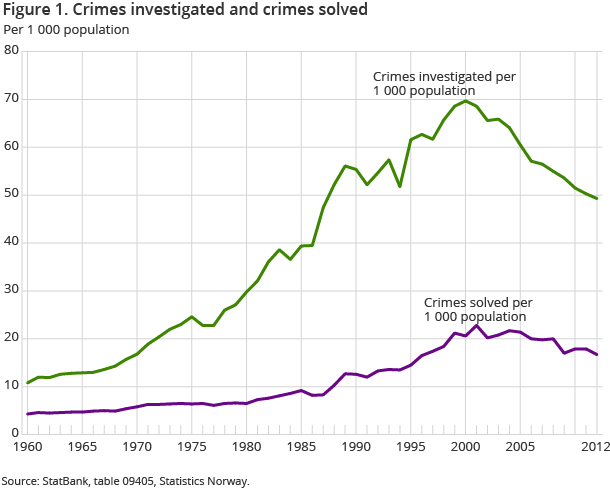
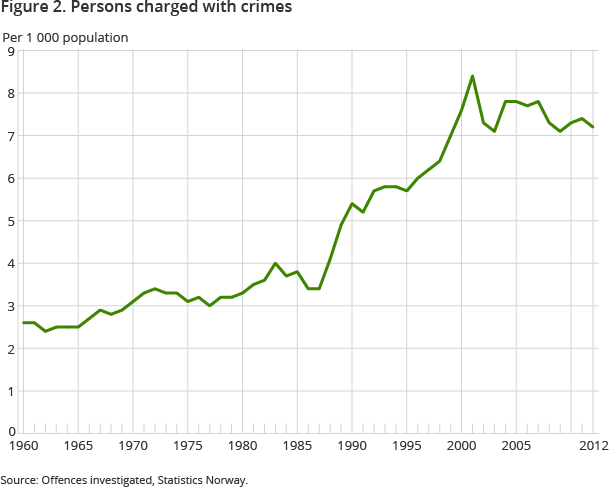
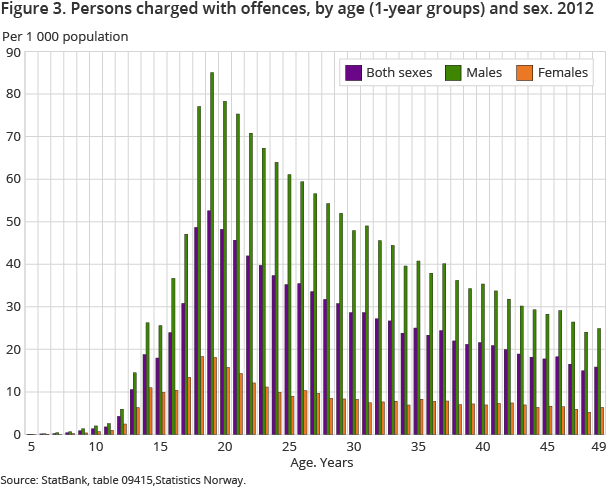
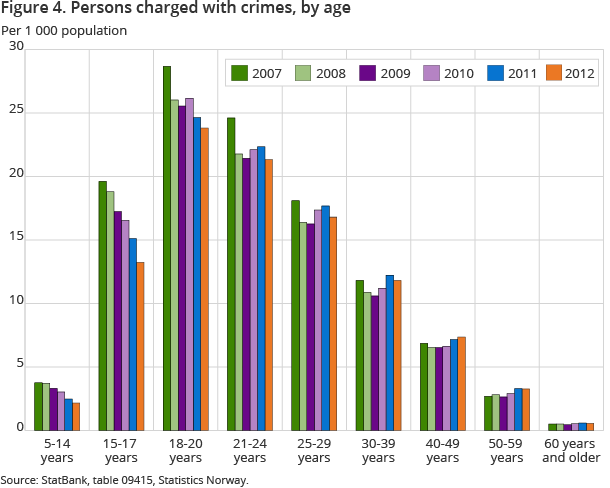
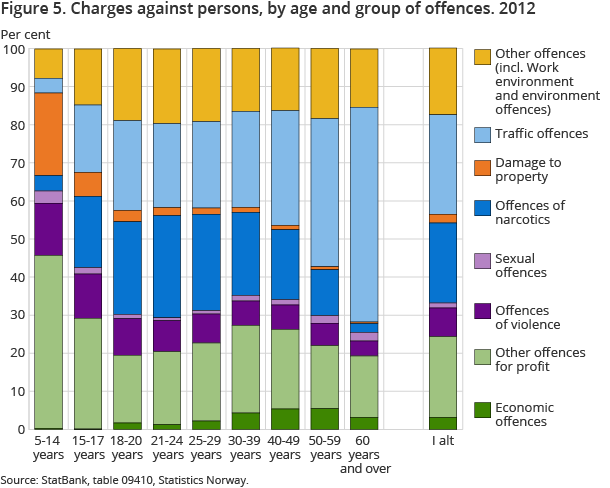
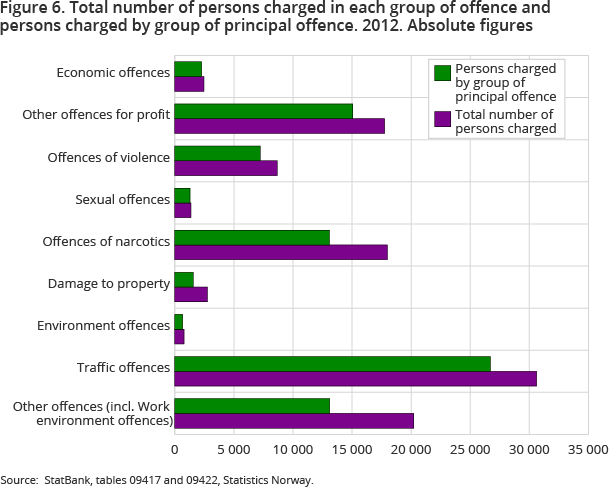
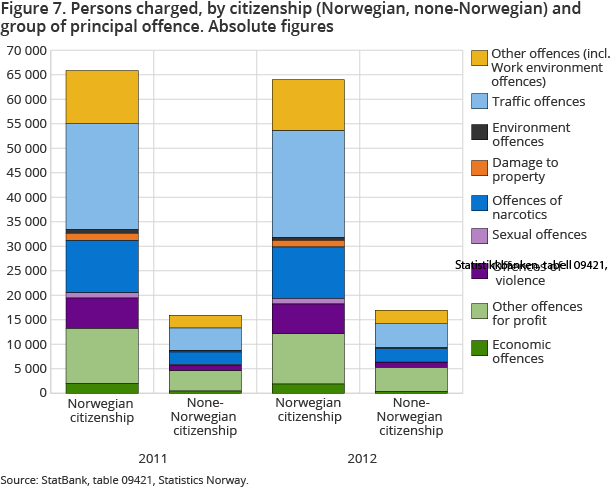
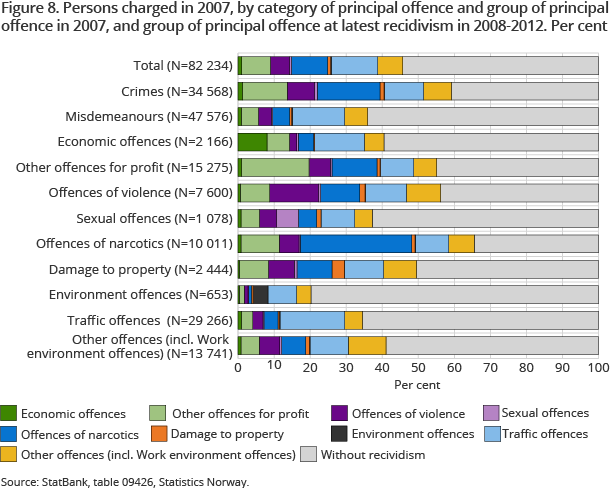
Of 359 800 completed offences investigated in 2012, 249 000 were crimes and 110 800 were misdemeanours. This was 1 800 fewer crimes and 1 500 fewer misdemeanours than in the previous year.
Fewer offences of narcotics and damage to property, but more offences for profit
The decrease in the number of offences investigated was greatest in the category offences of narcotics. The figure of 40 700 offences of narcotics in 2012 was more than 2 300 lower than in the previous year. There was also a decline for damage to property, with 1 700 fewer offences in 2012 compared to 2011.
In total, the investigation of 165 100 larcenies and other offences for profit were completed during 2012, which is 1 700 more than in 2011. As in the previous years, there is a major decrease for some types of larcenies, and a major increase for other types of larcenies. Among others, the long lasting drop in the number of recorded and investigated larcenies from cars and other means of transport continued in 2012. On the other hand, there was an increase in the number of recorded and investigated larcenies occurring in public places. Compared to the year before, there were 22 per cent more cases of simple larceny from cafes and restaurants and 8 per cent more bicycle thefts. A total of 25 600 offences in the category Other aggravated larceny were also investigated in 2012. Of these, 21 800 were incidents of aggravated larceny from a person in a public place, which is 24 per cent higher than in 2011 and 65 per cent higher than in 2010. (See also Offences reported to the police 2012 ).
Fewer solved offences of narcotics and larcenies
Of all offences investigated in 2012, more than 170 400 are regarded as solved and 189 400 as unsolved. Compared to other group of crimes, drug crimes have the highest share of solved cases. The share of solved offences of narcotics was, however, reduced from 88 per cent in 2011 to 86 per cent in 2012.
Offences for profit and damage to property are the groups of offences with the lowest share of solved offences, with 20 per cent in 2012. Of the more specific types of crimes, there are, however, substantial differences in the share of solved cases. For instance, more than 98 per cent of the investigated bicycle thefts and simple larcenies from cafes and restaurants were unsolved. In the category other aggravated larceny, almost 95 per cent were not solved.
Of all 129 700 larcenies investigated in 2012, over 85 per cent were dismissed due to lack of information on the perpetrator. Fewer than 13 400 larcenies resulted in prosecution, a ticket fine or another decision classified as solved. The total number of solved larcenies is the lowest amount registered since the beginning of the 1980s.
More unsolved larcenies reduced the share of solved crimes
In 2012, 77.5 per cent of all misdemeanours were solved; the same share as in 2011. However, the police and prosecution authorities solved 4 650 fewer crimes than in the previous year. In addition, 2 800 more crimes were dismissed as unsolved. The share of solved crimes in total dropped from 35.6 per cent in 2011 to 34 per cent in 2012.
Whether an offence is solved or not, and which legally binding decisions are made, vary substantially for the various groups of offences and types of offences. Differences in the compositions of types of offences are also responsible for many of the changes in the share of solved offences that we see from year to year. The decline in the share of solved crimes from 2011 to 2012 is mostly related to the increase in the number of reported and investigated cases of aggravated larcenies from a person in a public place, simple larcenies from cafes and restaurants and bicycle thefts. The decline in the number of investigated and solves offences of narcotics also led to this decline in the share of solved crimes.
Fewer charges and persons charged with crimes
In 2012, investigations by the police and prosecution authorities resulted in a total of 170 500 charges against 81 000 different persons. The total amount of charges is almost 4 per cent fewer than in 2011.
A total of 36 100 persons were charged for 89 500 crimes in 2012. This is 2.5 per cent fewer charged persons and 5.6 per cent fewer charges than in the previous year. In addition, 44 800 persons were charged for only misdemeanours. Of these, 26 700 charged persons had a traffic misdemeanour as their principal offence , and this group made up one third of all persons charged for offences in 2012. The number of persons charged for traffic offences or other types of misdemeanours is almost the same as in 2011.
8 per cent of all 19 year-old men charged with offences
The trend from the preceding years with a decline in the number of charged persons among younger youths continued in 2012. The decline from 2011 was largest among those under 18 years of age, where there was an 11 per cent drop in the number of charged persons. (See figure 4.) Persons under the age of majority made up 11 per cent of all persons charged with a crime in 2012; a considerably lower share than in for instance 1980 – when this group made up 35 per cent.
Persons in the age group 18-20 years are still most overrepresented among persons charged with offences, and 4.5 per cent of residents in Norway in this age group were charged in 2012. However, men are charged with offences much more often than women, and out of all 19 year-old men, about 8 per cent were charged with one or more offence. The corresponding share among 19 year-old women was less than 2 per cent. (See figure 3.)
The same high number of persons charged for narcotic offences
A total of 18 000 persons had 36 400 charges against them for narcotic offences. A considerably high share of these persons, 27 per cent, was also charged with other offences that have a higher sentencing framework and are classed under another principal offence group. In other words, 13 100 persons had one case of narcotic offence as their principal offence (see figure 6), which is almost as many as in the previous year, and considerably higher than in all previous years for which statistics are available.
A total of 17 800 persons had 36 800 charges against them for larcenies or other offences for profit in 2012. Of these, almost 15 100 were charged with offences for profit as their principal offence, which is a somewhat lower amount compared to the previous year, and almost 19 per cent fewer than in 2004.
Less violence among youths
In total, 8 664 persons were charged with one or more violent offences during 2012. These persons had a total of 13 075 charges against them for violent offences – of which 6 496 were for assault, 1 565 for bodily harm, 1 301 for assaulting a public servant, 565 for ill treatment within families (including serious ill treatment) and 2 738 for threats.
Both the total amount of persons charged with violent offences and the number of persons charged with this type of crime as their principal offence was lower in 2012 compared to the previous year. The trend from the preceding years continued, and the 7 230 persons charged with threats or other violent offences as their principal offence is 7.5 per cent fewer than the amount in 2007. The decrease during this period is mainly due to fewer men among the charged persons and a decline among charged persons in the age 20 years and younger. For instance, the number of persons charged in the age group 15-17 years with violent offences as their principal offence has fallen by as much as 43 per cent during the years 2007-2012.
The decrease in violent offences among the younger age groups during these years can also be seen in the statistics on victims of offences reported to the police and in the mapping of violence in the survey of living conditions.
More foreign citizens charged with offences for profit and traffic offences
Of those charged in 2012, 17 000 had non-Norwegian citizenship. This is approximately 1 000 more than in the previous year. Classified by offence group, 653 more persons were charged with offences for profit, where there was a major increase in the number of persons charged with simple larcenies, and 271 more persons charged with traffic misdemeanours.(See figure 7.)
In addition to the Norwegian citizens and the foreign citizens resident in Norway, there are also others who stay in Norway for shorter or longer periods of time and are charged with offences. The number of charged persons who are registered as a resident of another country has increased during recent years, and this group made up 7.6 per cent of all persons charged with offences in 2012. In combination, those resident and non-resident in Norway who had non-Norwegian citizenship make up 21 per cent of all persons charged with both crimes and misdemeanours in 2012.
The total increase in the number of persons with foreign citizenship charged from 2011 to 2012 was 6.5 per cent. This is less than the general increase of foreign nationals in the population, which during each of the past five years has been about 10 per cent (see Population statistics ).
Lower share with recidivism
The statistics on recidivism among residents of Norway indicate that 45.7 per cent of the 82 200 persons charged in 2007 were charged once or more during the period 2008-2012. This share has decreased gradually in the last five recidivism surveys, and was 49.6 per cent for those charged in 2002.
Classified by offence group, the highest rate of recidivism is among those charged with drug crimes as their principal offence, where 66.5 per cent were charged once or more during the subsequent five-year period. The corresponding share among those charged with violent offences or offences for profit was 56 per cent and 55 per cent respectively.(See figure 8.)
In the last recidivism survey, 64.4 per cent of all men charged in the age group 15-17 were repeat offenders. This is considerably lower than in the recidivism survey from the previous year, and we must go back to the persons charged in 1997 to find a lower share with recidivism in this group.
However, men in the age group 15-17 still have the highest rate of recidivism. As in previous years, the share of repeat offenders fell substantially with age among men. Among women, the recidivism rate is considerably lower, and the differences between the various age groups are much less pronounced among the women than the men. Almost one in every three women charged in 2007 were charged once or more during the subsequent five-year period.
Contact
-
Reid Jone Stene
E-mail: reid.jone.stene@ssb.no
tel.: (+47) 99 02 22 01
-
Siri Fjærtoft Fossanger
E-mail: siri.fossanger@ssb.no
tel.: (+47) 99 72 49 27
-
Sigmund Book Mohn
E-mail: sigmund.mohn@ssb.no
tel.: (+47) 94 32 77 22
